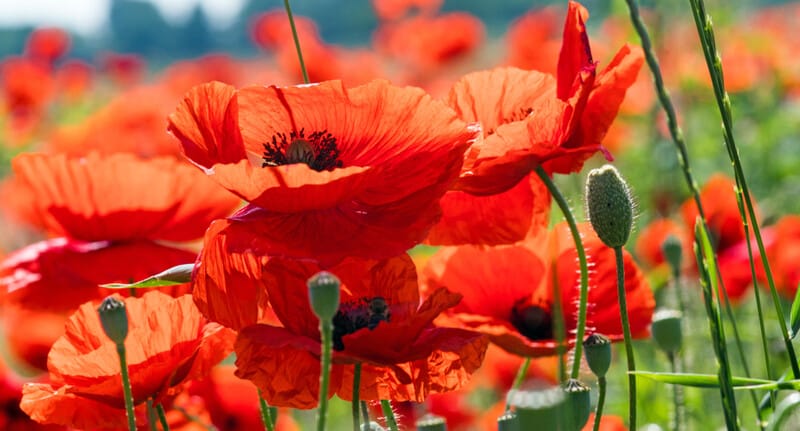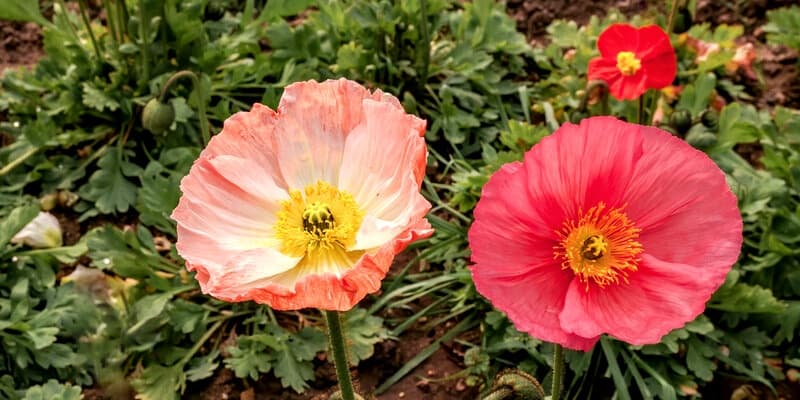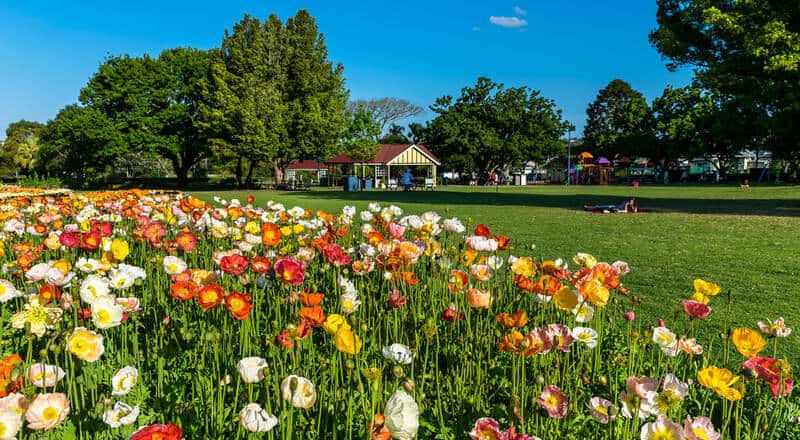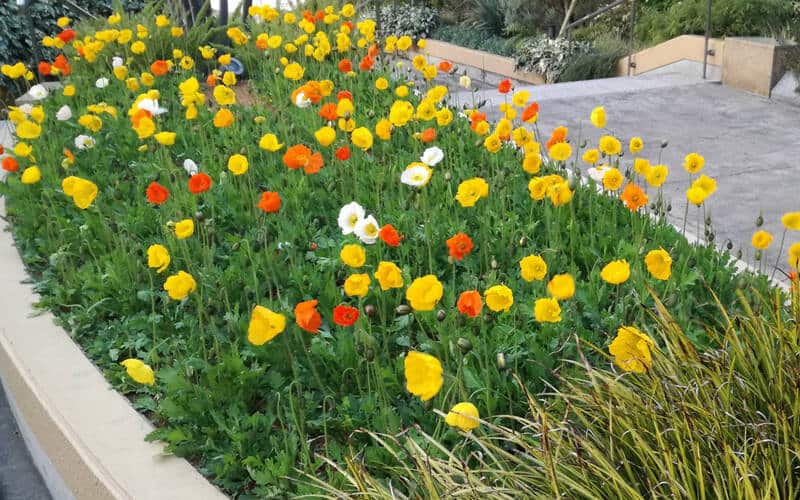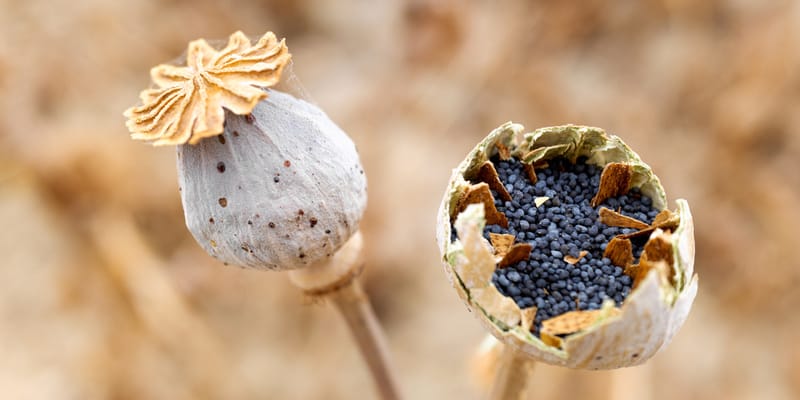The poppy flower is an iconic and stunning sight. The poppy (papaver rhoeas) is a popular garden flower, and the perfect plant for brightening your garden after winter. Year after year, you’ll get those bursts of colour as the red flowers pop up to greet the sun. And if you don’t have them yet, then here’s how to plant poppies in a garden!
Poppy flowers are very easy to grow. Since poppy seeds need light to germinate, you can simply sprinkle them on the ground where you want that signature pop of colour. Some poppies even self seed, so you’ll have to watch out unless you want them everywhere! Then just water lightly so they don’t get waterlogged.
You can grow these flowers from poppy seed, and you can keep them in pots or out in your garden. However you want to plant poppies, they’ll make an eye-catching display among green foliage — ready to grab the attention of anyone who passes by.
About Poppies
The red flowers of the poppy (papaver rhoeas) are famous around the world. They’re well-known as a symbol for heroes of World War I, since they grew all over fields of battle. Now the Flanders variety is an international symbol of commemoration for Remembrance Day.
Poppies originated in Europe, and across mountains in Asia and North America. They generally prefer cooler climates, but there are varieties that can tolerate warmer weather.
Depending on when you plant them, poppies will bloom in spring or summer. Sow in autumn for a burst of red flowers after winter, or sow in spring to add to the warmth of summer. They’ll also attract bees and butterflies for a colourful show!
Types Of Poppies
The Flanders poppy is likely the most recognisable, while the Iceland poppy is the most popular to grow. But there are several varieties of poppy flowers for you to cultivate, based on your climate zone and aesthetic.
The Iceland poppy is one of the most popular of poppy flowers since it grows readily in most climates. Besides the iconic scarlet, it also comes in shades of yellow, salmon, and white! Iceland poppies have long stems and good shelf life, so they’re great for display.
The Flanders poppy is the symbol of remembrance, with distinctive blood red petals around a black centre. They’ll thrive better in climates with cooler winters, and flower annually.
The Californian poppy provides gardeners with the largest blooms of all poppy varieties. Its colour is more orange than red, although it also comes in bright or pale yellow. This variety self seeds easily, however, so think twice if planting in bushland areas!
The Opium poppy is an excellent choice for culinary use. Its seeds are edible, and provide great crunch when used in pastries and breads. Just don’t eat any other part of the poppy plant — those are poisonous!
If you want poppies in the shade, plant a Welsh poppy! This variety is easy to grow in cooler climates, but can handle some warmth and dryness. Welsh poppies come in a golden shade, with rare cultivars in red and orange. Just note that their seeds take a while to germinate, and they’ll thrive in slightly acidic soil.
Planting Poppies
When to plant poppies in Australia
While poppies grow well in most climates, the time at which you plant them differs. In more temperate climates, sow poppy seeds through autumn. In cool climates, plant poppies from summer to early autumn. In tropical and subtropical climates, it’s best to sow seeds from early autumn to winter.
Soil
Like most plants, the poppy flower will thrive best in loose, well drained soil that is slightly acidic. Prep your soil bed or potting mix beforehand by enriching it with organic material and forking it well. You can get a professional gardener to help prep your soil, and maintain your plants after!
Location
Most poppy flowers like full sun, so choose somewhere warm but sheltered from strong wind. As mentioned, though, Welsh poppies can thrive in partial to full shade – they can act as companions to taller, wider plants.
How To Grow Poppies
While some varieties (such as the oriental ones) can be propagated from mature plants, it’s very easy to sow poppies from seed! Here’s how to plant poppy flowers right in your garden.
How to grow poppies from seed
Poppy seeds need to be sown lightly. Choose a sunny spot in your garden, and weed the area. Rake the soil to a fine tilth.
Sprinkle the poppy seeds across the ground thinly and lightly.
Poppies will take 7–30 days (or 1–4 weeks) to germinate, so be patient! Germination depends on poppy variety, soil condition, and climate.
Keep soil moist, but not soaked during germination. Use a fine spray so your poppy seedlings don’t get waterlogged.
When the seedlings are a few centimeters high, transplant them or thin them out so they’re 20–30cm apart.
Continue spraying gently and regularly until your plants are established. You can lightly mulch using organic matter, but keep it away from the stems!
How to grow poppies in pots
Growing poppies in pots isn’t difficult — just use a medium-sized container with drainage holes, so your potting mix drains well. They also need to be placed somewhere where they get 6–8 hours of sunlight a day.
Mix potting soil with some compost to create humus-rich, loamy soil, the perfect environment for poppies to grow. Fill your pot up to about 4cm from the top.
Sow poppy seeds directly onto the soil — no need to cover, since they need sunlight to germinate. Gently water your potting mix so it’s moist, but not waterlogged.
Once the seeds have germinated and have reached around 10–13cm, thin them out so they’re 10–15cm apart. Continue spraying lightly until established.
Caring For Poppy Flowers
Dividing
It’s recommended to divide poppy clumps in late summer to autumn so the taproots can regrow. But don’t do this too early — you could damage the taproot, and lose a season of blooms!
Watering
Once settled, poppies only need limited watering. Check to see if the top few centimeters of soil are dry before spraying gently. Too much water can result in leggy and unattractive flowers!
Deadheading and seed harvesting
Deadhead the early buds of your poppy plants to encourage good flower growth. This involves removing any spent or withered flowers after blooming. (It’ll also help prevent any unwanted self-seeding!)
To harvest seed pods after flowering, harvest the pods when they’re light brown. Dry them for 1–2 weeks before breaking them open.
Fertilising
If you added compost before planting, then your poppies will not need much more feeding. You can add some eco fertiliser during the growing season to encourage bigger flowers. And the bigger and brighter the flowers, the better they’ll look when you pick them for display — the best reward for growing poppies right at home.


